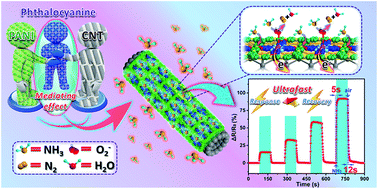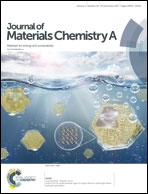Phthalocyanine-mediated non-covalent coupling of carbon nanotubes with polyaniline for ultrafast NH3 gas sensors†
Abstract
The development of innovative methods for the integration of carbon nanotubes (CNTs) and polyaniline (PANI) that preserve their exceptional quality, while robustly enriching their gas-sensing features, is still rare and remains challenging for the realization of rapid and sensitive gas detection. Herein, due to the advantages in its structure, tetra-β-carboxyphthalocyanine cobalt(II) (TcPcCo) acts not only as a sensing promoter, but also as an efficient mediator to couple multi-walled CNTs (MCNTs) with PANI, resulting in MCNT@PANI hybrids with a uniform 3D network; the planar 18π-electrons in TcPcCo allow it to closely conjugate on the surface of MCNT by π–π interactions; moreover, the outer –COOH groups in TcPcCo prompt it to link with the aniline monomers based on acid–base interactions. During the subsequent polymerization process, TcPcCo also serves as a protonic acid doped into PANI, increasing the electronic conductivity of PANI. Due to the specific selectivity of TcPcCo, high sensitivity of PANI towards NH3, and good conductivity and stability of the MCNTs, the obtained core–shell MCNT@PANI hybrids demonstrate radically enhanced NH3-sensing performance, especially in terms of response/recovery duration (∼5.0 s/12.0 s to 100 ppm NH3) and selectivity, outperforming the single components and previously reported materials at room temperature. In addition, the MCNT@1.0PANI hybrid shows a superior sensing sensitivity (140.99% to 100 ppm NH3) as well as remarkable stability over 60 days. The proposed strategy, TcPcCo-mediated non-covalent coupling of MCNT with PANI, is of potential importance towards the design and construction of ideal materials for future sensing devices, as well as many other applications.



 Please wait while we load your content...
Please wait while we load your content...